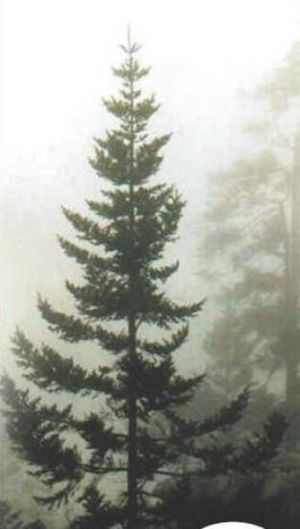Guatemalan fir facts for kids
Quick facts for kids Guatemalan fir |
|
|---|---|
 |
|
| Abies guatemalensis in the San Miguel Los Altos Reserve, Totonicapán, Guatemala | |
| Conservation status | |
| Scientific classification |
The Guatemalan fir, also known as pinabete or Abies guatemalensis, is a special evergreen tree. It means it stays green all year round. This tree grows naturally in Central America. It is the most southern type of fir tree in the world. You can find it from southern Mexico down to Honduras and El Salvador.
This fir tree loves warm, wet places. It grows in tropical mountain forests, often in cloud forests. These are forests where clouds often cover the mountains. The Guatemalan fir does not like frost at all. Sadly, this beautiful tree is now considered endangered. This is because too many trees have been cut down, and their natural homes are disappearing. Because it is threatened, the tree is protected by an international agreement called CITES.
Contents
What Does the Guatemalan Fir Look Like?
The Guatemalan fir is a tall tree that grows in a cone shape. It can reach heights of 20 to 35 meters, which is like a 7 to 12-story building! Its trunk can be 60 to 90 centimeters wide. The branches spread out mostly sideways.
Bark and Branches
The tree's bark is dark brownish-black. It looks like it is divided into plates. The smaller branches are reddish-brown to very dark reddish-black. They feel a bit fuzzy. The tree's buds are round and covered in a sticky sap. They are about 5 millimeters long.
Leaves and Cones
The leaves of the Guatemalan fir are deep green on top. They feel waxy underneath. They are arranged a bit like a comb. Each leaf is between 1.5 to 5.5 centimeters long and about 1 to 2 millimeters wide. The tip of each leaf has a small notch.
The female cones are shaped like long cylinders. Their tips can be pointy or a bit flat. They are yellowish-brown with a purple tint. These cones are usually 8 to 11.5 centimeters long and 4 to 4.5 centimeters wide. Inside the cones are the seeds. These seeds are light brown and have a wing that helps them fly away in the wind.
Types of Guatemalan Fir
There are two main types, or varieties, of the Guatemalan fir. They are slightly different and grow in different areas:
- The common type: This is called A. g. var. guatemalensis. It is found in most of the tree's range. You can see it in Guatemala, El Salvador, Honduras, and parts of Mexico. These Mexican states include Chiapas, Colima, Guerrero, Oaxaca, and Tamaulipas.
- The Jalisco type: This type is called A. g. var. jaliscana. It only grows in the northern part of the tree's range. You can find it in the Mexican states of Jalisco, Michoacán, Nayarit, and maybe Sinaloa.
Why the Guatemalan Fir is Endangered
The Guatemalan fir is listed as endangered by the IUCN. This means it is at a very high risk of disappearing forever. The main reasons are that people cut down too many trees for wood and the places where they live are being destroyed.
Threats to the Fir Tree
This tree grows best in rich, fertile soil. This kind of soil is also good for farming, especially for growing coffea (coffee) plants. So, people often clear the forests where these firs grow to make farms. In the past, around the 1940s, this tree was very common. Now, large groups of these trees are rare. In Guatemala, most remaining forests with these trees are smaller than 3 square kilometers.
Another problem is that the cones, which hold the seeds, do not always grow well. And when they do, the seeds often do not sprout into new trees.
Conservation Efforts
The largest and best-protected area of Guatemalan firs is in Los Altos de San Miguel Totonicapán in Guatemala. This forest is about 26,060 hectares big. However, even this area is threatened by illegal logging, which means people are cutting down trees without permission.
Because the tree is endangered, it is now illegal to cut it down in some countries. It is also listed in CITES Appendix I. This means it is against the law to buy or sell these trees, or parts of them, across international borders. Groups like the Central American And Mexico Coniferous Resources Cooperative (CAMCORE) are also working to protect the tree in its natural habitat.
Where it Grows in Mexico
In Mexico, the Guatemalan fir grows on the western slopes of the Sierra Madre del Sur and the southern Sierra Madre Occidental mountain ranges. It is found in states like Chiapas, Oaxaca, Guerrero, Michoacan, Colima, Jalisco, Nayarit, and Zacatecas. It usually grows on volcanic soil at high elevations, between 1800 and 3700 meters. These areas have a cool, moist climate, often influenced by the ocean.
See also
 In Spanish: Pinabete para niños
In Spanish: Pinabete para niños


